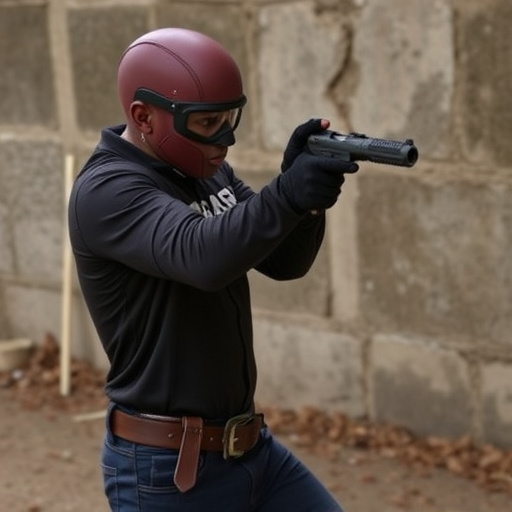Pepper spray, a strategic defense mechanism, requires proper handling, storage, and deployment for maximum effectiveness. Choosing the right spray depends on individual needs and environment, with factors like range and concentration. The Pepper Spray Holster Placement Guide aids in selecting discreet, accessible holster spots, balancing comfort and ease of use. Understanding local laws, effective deployment techniques, and regular practice enhance its reliability as a self-protection tool.
“Uncover the ultimate self-defense tool—pepper spray, a powerful deterrent in the right hands. This comprehensive guide explores the benefits and safety aspects of carrying pepper spray, helping you make an informed choice. From understanding its active ingredients to selecting the ideal type for your needs, we cover it all. Additionally, we provide an essential Pepper Spray Holster Placement Guide, ensuring secure and efficient access during emergencies. Learn legal considerations, effective use techniques, and gain confidence in utilizing this valuable personal safety resource.”
- Understanding Pepper Spray: Benefits and Safety Precautions
- Choosing the Right Pepper Spray for Your Needs
- The Ultimate Guide to Pepper Spray Holster Placement
- Legal Considerations and Effective Use Strategies
Understanding Pepper Spray: Benefits and Safety Precautions
Understanding Pepper Spray: Benefits and Safety Precautions
Pepper spray, a non-lethal self-defense tool, has gained immense popularity due to its effectiveness in neutralizing attackers temporarily. It works by irritating the eyes, nose, and throat, causing a burning sensation and temporary blindness, giving users precious time to escape or seek help. When used strategically, pepper spray can be a powerful defense mechanism, especially when carried discreetly with a well-placed Pepper Spray Holster.
However, safety precautions are paramount. Users should familiarize themselves with the spray’s range, usage instructions, and any potential health risks. Proper storage and regular maintenance of the device are crucial to ensure its longevity and reliability in emergency situations. Knowing how to deploy pepper spray swiftly and accurately can make all the difference in self-defense scenarios, making it an invaluable asset for personal safety.
Choosing the Right Pepper Spray for Your Needs
Choosing the right pepper spray is a critical step in ensuring its effectiveness as a self-defense tool. Consider your specific needs and environment when selecting a pepper spray. For example, if you’re embarking on outdoor adventures, opt for a spray with a longer range and stronger concentration to deter potential threats from a distance. Alternatively, if you’re looking for a discreet option for everyday carry, smaller, more compact sprays with shorter ranges might be preferable, allowing for easy stowage in hidden pepper spray holster placements like pockets or belt loops.
Referring to a Pepper Spray Holster Placement Guide can help determine the best spots to conceal your spray for rapid access. The choice should align with comfort and ease of use. Keep in mind that factors like weather conditions and the legal restrictions in your area also influence the type of pepper spray you choose. Always opt for reputable brands that provide clear instructions and guarantees on their products’ quality and performance.
The Ultimate Guide to Pepper Spray Holster Placement
Choosing the right pepper spray holster is only half the battle; proper placement is crucial for its effectiveness. The ultimate Pepper Spray Holster Placement Guide involves understanding your body and the situations you’re likely to encounter. For optimal reach, place it on your non-dominant side, accessible yet discreet. A waistband holster is a popular choice for easy drawing, especially during low-light or high-stress scenarios. Alternatively, a pocket holster offers more protection from accidental discharge but may be less quick to access.
Consider your clothing and environment too. In colder climates, consider a warmer layer over the holster to prevent freezing. In hotter environments, ensure it’s secure yet allows for easy air flow to prevent overheating. The key is balance—balance between accessibility, comfort, and security to maximize your pepper spray defense when it matters most.
Legal Considerations and Effective Use Strategies
When considering a pepper spray defense, it’s crucial to understand the legal implications in your jurisdiction. Different regions have varying laws regarding the possession and use of pepper spray, so it’s essential to familiarize yourself with local regulations to ensure compliance. Some areas may require permits or registration for certain types of pepper spray, while others might restrict its use solely to law enforcement or personal protection. Knowing these boundaries will not only protect you legally but also help determine the most effective strategies for deployment.
Effective use strategies involve understanding Pepper Spray Holster Placement Guide principles. Proper holster placement ensures quick and easy access during a threatening situation. A well-placed holster, often worn on the belt or in a pocket, allows for swift retrieval without causing hindrance to your movements. Training in target acquisition and de-escalation techniques is vital; aiming for the eyes and face, areas like the neck, and using breathing control can significantly reduce the impact on bystanders while neutralizing threats. Regular practice enhances your comfort level with this defense mechanism, making it a valuable tool in self-protection scenarios.
Pepper spray is a powerful personal defense tool, but its effectiveness depends on proper usage. By understanding the benefits and safety precautions, choosing the right spray for your needs, and mastering the art of holster placement (as detailed in our Pepper Spray Holster Placement Guide), you can ensure it serves as a reliable and strategic defense option. Always stay informed about legal considerations to use this tool responsibly and effectively when facing potential threats.
